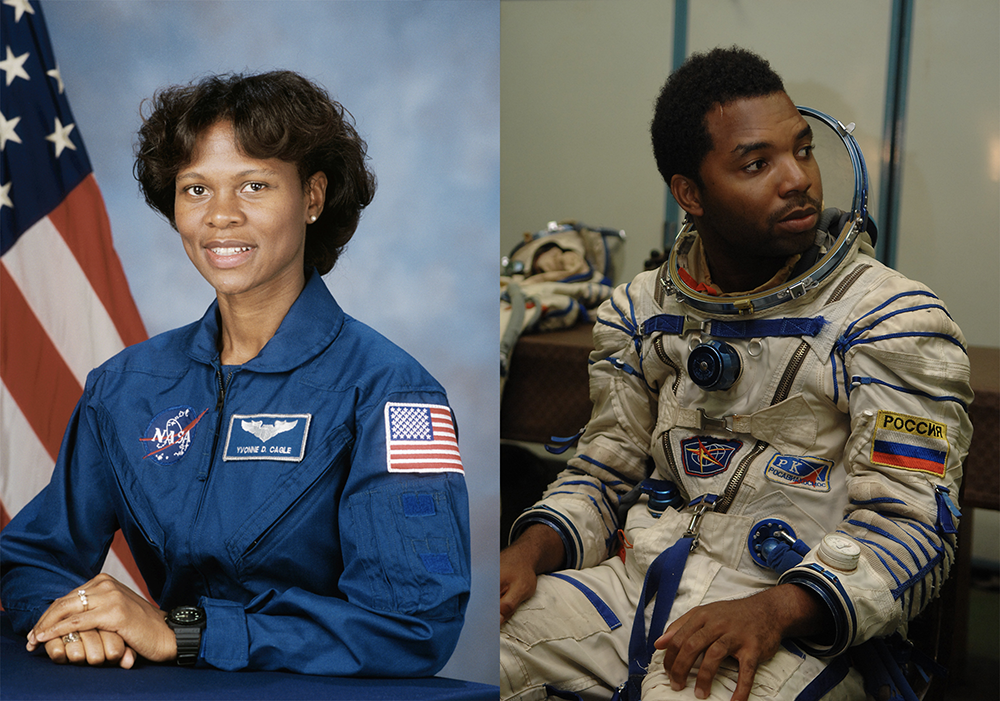
Free, Talks
Astronaut Yvonne Cagle and Artist Tavares Strachan in Conversation
Thursday, Sept 26, 2019
7 p.m.
Phyllis Wattis Theater, Floor 1
Free. Museum admission not required.
First come, first served. RSVP encouraged.
On view fifty years after the first moon landing, the exhibition Far Out: Suits, Habs, and Labs for Outer Space reflects on the imaginative ways we dream of life beyond earth. Today, new research, design, and technologies are making what was once science fiction a reality. On this evening, two special guests join us to expand on these topics: NASA astronaut Dr. Yvonne Cagle and multidisciplinary artist Tavares Strachan, whose work is featured in Far Out as well as the upcoming contemporary art exhibition, SOFT POWER. Together, Cagle and Strachan will discuss the challenges and marvels of space travel, the significance of surfacing what is often hidden or invisible, and what happens to the human body and mind in extreme environments.
In her illustrious career, Dr. Cagle has long worked at the intersection of medicine and the human body in flight, from her time serving as a flight surgeon in the US Air Force, to her contributions at NASA to astronaut health and medical standards, as well as to research on such topics as the human body in zero gravity. Strachan, meanwhile, has approached outer space through his extensive art practice, going so far as to train at the Yuri Gagarin Cosmonaut Training Center in Russia. His 2018 project, ENOCH, in collaboration with LACMA and SpaceX, launched a satellite into orbit, honoring the legacy of Robert Henry Lawrence Jr., the first African American astronaut selected for any national space program.
This conversation will be moderated by Eva Díaz, associate professor in the History of Art and Design department at Pratt Institute and author of the forthcoming book After Spaceship Earth: The Critique of Total Design in Contemporary Art.
About the Speakers
Dr. Yvonne Darlene Cagle is an astronaut for the National Aeronautics and Space Administration (NASA), and consulting professor for Stanford University’s department of cardiovascular medicine and its department of electrical engineering. Dr. Cagle was previously the chief scientist for the Level II Program Office of NASA’s Commercial Reuseable Suborbital Research program. She is currently NASA’s lead astronaut science liaison and strategic innovations manager for Silicon Valley. Her groundbreaking work is preserving NASA legacy data while galvanizing NASA’s lead in global mapping, sustainable energies, green initiatives, and disaster preparedness.
Tavares Strachan is a multidisciplinary artist whose practice mobilizes our visual, intellectual, and emotional faculties. Aeronautical and astronomical science, deep-sea exploration, and extreme climatology are just a few of the thematic arenas out of which Strachan creates performative allegories that tell of cultural displacement, human aspiration, and mortal limitation. His years-long multimedia project, Orthostatic Tolerance (2004–2011), incorporated photography, video, drawing, sculpture, and installation documenting Strachan’s experience in cosmonaut training at the Yuri Gagarin Cosmonaut Training Center in Star City, Russia, and in experiments in space travel conducted in Nassau under the Bahamas Air and Space Exploration Center (BASEC) — the artist’s version of NASA for his native country.
Eva Díaz (moderator) is associate professor in the History of Art and Design department at the Pratt Institute in New York City. Díaz recently completed the manuscript of her new book After Spaceship Earth: The Critique of Total Design in Contemporary Art, analyzing the influence of R. Buckminster Fuller in contemporary art. The most recently completed sections of the book focus on contemporary artists’ projects challenging a privatized and highly-surveilled future in outer space, and how the space race and colonization can be reformulated as powerful means to readdress economic, gender, and racial inequality, as well as ecological injustice.